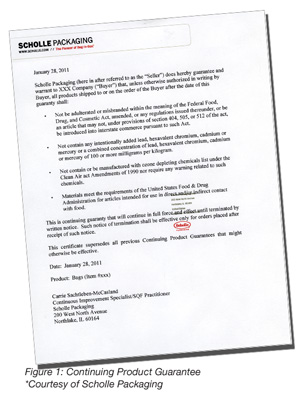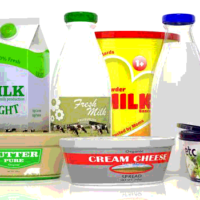The food package, whether it is the primary or secondary package, serves a number of different roles. It protects the food, provides the consumer with information, helps to market the food, warns customers of potential dangers (allergen-sensitive persons), provides a container for transport, allows the product to be tracked and traced and can even provide evidence as to how a product might have become contaminated or have spoiled. Packages now have the capability of allowing a consumer or user to understand how fresh a product might be. We also need to ask whether the food package is something that could pose a health risk or an issue that could pose a hazard that is reasonably likely to occur.
Let’s take a look at some of the roles a package plays. There are dozens of packages that are used for food. These include cans made from steel, aluminum, paper or paper composites and plastics, bottles manufactured from glass, different plastics or composites, bags from plastic, metallized films or combinations of both, wrappers from different materials, composite boxes and many, many more. Different types of packages are employed throughout the world. For example, in Europe, catsup, mayonnaise, tomato sauce, mustard and other products are marketed in what Americans would call a toothpaste tube.
All food products require some form of protection. The reasons for protecting the products include ensuring their safety, prevention of spoilage and ensuring the integrity of the packaged item. Consumers expect that products be safe, wholesome and integral. In other words, when one buys a bag of potato chips, they expect chips, not crumbs. The package does just that.
To the marketing person, the package is a means of marketing the product. The company logo, colors, graphics and even the type of package are all designed to attract the consumer’s attention and get them to buy the item.
The food package also provides the customer with information about nutrition, the ingredients that make up the product, where those ingredients may have come from and whether the product contains any allergens. The package also tells consumers that the product may have potential health benefits: heart healthy, cancer prevention or another benefit. In addition, many labels describe how the products should be stored or prepared to ensure that they are safe.
Each and every package also should have a code, “use by” or “best by” date or some other identifying mark. This code is essential for identifying the product and, if there is a problem, tracking the product so it can be recalled or held. Therefore, the code can ultimately help ensure that the public is protected. With radio frequency identification tags, products can even be tracked electronically. Coding and traceability are now mandated by the U.S. Department of Homeland Security.
Packaging and Health
 Does packaging pose a heath risk? There are some who say, “yes,” but true packaging professionals say, “no.” If it was hazardous, it would not be allowed to be used as a packaging material. Each and every material, including inks and dyes, used as or in a food contact package must be manufactured from materials that are approved by the regulatory agencies as acceptable for food contact. In the U.S., these standards may be found in the different sections of 21 CFR Parts 175–178. There are similar documents for the European Union. In fact, all processors should demand that their packaging suppliers provide them with letters of continuing guaranty, stating that the materials that they supply are approved for food contact use. This letter should reference both the compound used in the material plus cite the specific section of the regulation. In addition, it is a good idea for processors to keep these files updated. Asking the packaging supplier to provide such a letter on a yearly basis is not a bad idea. This is also something that auditors will almost always ask for when conducting an audit. A sample of such a letter may be seen in Figure 1.
Does packaging pose a heath risk? There are some who say, “yes,” but true packaging professionals say, “no.” If it was hazardous, it would not be allowed to be used as a packaging material. Each and every material, including inks and dyes, used as or in a food contact package must be manufactured from materials that are approved by the regulatory agencies as acceptable for food contact. In the U.S., these standards may be found in the different sections of 21 CFR Parts 175–178. There are similar documents for the European Union. In fact, all processors should demand that their packaging suppliers provide them with letters of continuing guaranty, stating that the materials that they supply are approved for food contact use. This letter should reference both the compound used in the material plus cite the specific section of the regulation. In addition, it is a good idea for processors to keep these files updated. Asking the packaging supplier to provide such a letter on a yearly basis is not a bad idea. This is also something that auditors will almost always ask for when conducting an audit. A sample of such a letter may be seen in Figure 1.
Of course, this does not stop persons from questioning the safety of materials used in packaging. The material that is currently being targeted is bisphenol A (BPA). BPA is an industrial chemical used to make a hard, clear plastic known as polycarbonate, which has been used in many consumer products, including reusable water bottles and baby bottles. BPA is also found in epoxy resins, which act as a protective lining on the inside of metal-based food and beverage cans. There are people who believe this compound poses a potential health risk, especially if the compound is subjected to heating or microwaves. In addition, since many packages used for infant formula contain the compound, there is concern about exposing a more sensitive population. The compound has been examined by toxicologists from both the European Union and the U.S. According to an update issued by the U.S. Food and Drug Administration (FDA) in January 2010,
“Studies employing standardized toxicity tests have thus far supported the safety of current low levels of human exposure to BPA. However, on the basis of results from recent studies using novel approaches to test for subtle effects, both the National Toxicology Program at the National Institutes of Health and FDA have some concern about the potential effects of BPA on the brain, behavior and prostate gland in fetuses, infants and young children. In cooperation with the National Toxicology Program, FDA’s National Center for Toxicological Research is carrying out in-depth studies to answer key questions and clarify uncertainties about the risks of BPA.”
FDA is encouraging industry to look for alternatives to BPA but has not banned the material.
There have been situations in which packaging has been identified as the cause of health issues. One such example was the botulism outbreak and recall of 1982.[1] In this case, there were Type E botulism cases attributed to canned salmon packaged in Alaska. The can had a defect (a triangular tear called the Index Defect) that was caused when the flattened can was formed into a cylinder. The botulinum spores gained access to the can after processing, grew out and produced toxin. The packaging was blamed for the outbreak, but it was the forming operation that was the actual cause. Investigators determined that the flattened can blanks, which were loaded into the reformer magazine, were torn or damaged when being transferred from the magazine to the former.
This problem did, however, have a silver lining. The salmon industry not only made a concerted (and successful) effort to improve product handling, sanitation and processing operations, but also adopted a new canning technology. The new technology was the one-piece can. Shipping materials to Alaska is expensive, so processors have always worked to make shipping more effective. Flattening body blanks for canning allowed more cans to be shipped. After the botulism issue, the one-piece can allowed the same economies in shipping. This can was tapered, allowing it to be nested and shipped. Since the cans were already formed, all the operators needed to do was fill, seal and process the containers. There were problems that had to be resolved when they were first used, but the industry addressed those issues, and the result was a safer product.
Packaging and Food Spoilage
As noted above, one of the roles of the food package is protection: protection from food pathogens, spoilage organisms, pests, tampering, damage, etc. Packaging materials that have been properly used should not pose a problem in any of these areas. However, there are times when processors accidentally use or select the wrong materials to be used with their foods. All food processors should consider either keeping a packaging scientist on their staff or utilizing a packaging expert when it comes to selecting the proper packaging materials.
The selection or use of the wrong material for a food package can create serious problems. For example, a sealing compound on a lid that is used for tomato paste may be ineffective if used for a tomato sauce containing oil. I have seen cases in which the oil actually dissolved the sealing compound and caused leaks. One problem that is often seen among processors in developing nations is the large number of crushed cases in warehouses. Processors buy inexpensive cardboard for casing finished products that is often weak and has very little tolerance for moisture. The result is that cases begin to flatten as they remain in refrigerated or frozen storage.
For all food plants, the most important element in packaging foods is properly following established procedures. There is a reason that checklists are used during start-up. Temperatures and contact times for heat-sealing elements have been established to ensure optimum seals, which all must be monitored. The low-acid canned food regulations state the following in 21 CFR Part 113.60 – Containers:
(a) Closures. Regular observations shall be maintained during production runs for gross closure defects. Any such defects shall be recorded, and corrective action taken and recorded. At intervals of sufficient frequency to ensure proper closure, the operator, closure supervisor or other qualified container closure inspection person shall visually examine either the top seam of a can randomly selected from each seaming head or the closure of any other type of container being used and shall record the observations made. For double-seam cans, each can should be examined for cutover or sharpness, skidding or deadheading, false seam, droop at the crossover or lap and condition of inside of countersink wall for evidence of broken chuck. Such measurements and recordings should be made at intervals not to exceed 30 minutes. Additional visual closure inspections shall be made immediately following a jam in a closing machine, after closing machine adjustment or after startup of a machine following a prolonged shutdown. All pertinent observations shall be recorded. When irregularities are found, the corrective action shall be recorded.
(1) Teardown examinations for double-seam cans shall be performed by a qualified individual, and the results there from shall be recorded at intervals of sufficient frequency on enough containers from each seaming station to ensure maintenance of seam integrity. Such examinations and recordings should be made at intervals not to exceed 4 hours. The results of the teardown examinations shall be recorded, and the corrective action taken, if any, shall be noted.
All processors manufacturing processed foods should establish a program such as this for monitoring the integrity of closures. Even a safe product can become rancid or stale as a result of a poor quality seal.
Of course, there are occasions when the packaging can be deemed part of the cause of a problem. In such situations, the fault usually lies not with the package but how the process operation was running. I was once asked to trouble-shoot a problem for a company. They were packaging honey in clean, sanitary drums. The product was packed hot for ease of pumping. The company experienced sporadic complaints from clients that there was mold on the top of the drum. The hot fill had allowed condensate to form on the underside of the lid, which dropped back onto the top of the honey, forming an area with higher water activity. The mold grew in spots. The solution was to invert the drum after filing and hold as such for 1 day, preventing moisture from accumulating. Mold can be an issue with some products, however. Snack cakes that are packaged in an impermeable film when they are too warm or subjected to fluctuations in temperature can absorb moisture and begin to mold. The package was a contributing factor, but the actual cause was poor manufacturing or shipping practice.
Packaging to Ensure Safety
Package labels provide customers with a great deal of information. The allergen labeling regulations clearly state that all allergens must be clearly identified on the package. Many processors use a statement such as seen below after the ingredients statement to ensure that allergens in the product are clearly defined:
“This Product Contains Milk and Soy”
There are many other statements that are used, but the bottom line is to inform.
Many products contain cooking instructions. These include meats, poultry and products with meat, frozen entrees, pizzas, pastas and rice and literally almost anything that is consumed. The instructions are designed to ensure a quality experience and that the food is safe. Since many foods are marketed as partially cooked or raw, the processor relies on the end user to process and handle the product according to instructions.
The role of packaging as a means for protecting consumers has expanded recently. Many ingredient suppliers have realized that by clearly labeling allergens on the cases and/or pallets, they now have a value-added item. Many industrial users are starting to demand such labeling. This is a simple thing for the supplier to do, stating on the case using colored inks or larger print that the product “CONTAINS WHEAT” or “CONTAINS WHEAT AND EGG.” Other suppliers have placed large, brightly colored stickers on their products that simply say “ALLERGEN.” This kind of labeling reminds the processor that the product contains an allergen and should be handled accordingly.
What Is the Real Threat?
Is packaging a potential problem when it comes to food safety? The answer is an emphatic “NO.” All materials used in packages must be approved for use in food contact applications. If questions are raised about a compound or a product, the industry and government will move to evaluate the material.
Can packaging cause problems? Of course. Packaging can cause problems and be identified as part of the problem in investigations into product spoilage, loss of shelf life or other issues. However, in most cases, it is not the packaging material per se that is the villain. The cause is usually improper sealing or packaging operations, the selection of the wrong material for that process operation or subjecting the packaging materials to conditions that aggravate a situation, much like the moldy snack cake.
Packaging is and will remain an evolutionary science and technology. It is a discipline that constantly learns from its mistakes and has evolved rapidly over the past 20 years. Take a walk through your local market and you will see packages on the shelves that weren’t there a few years back. One word of advice to the food processor, however; when looking to change packages or materials, look to a packaging professional for help. Go to your suppliers, a consultant or someone in academia who understands the science and technology of packaging. They can help you not only find the best materials but help troubleshoot problems and reduce costs. Seek to do it right the first time around.
Richard F. Stier is a consulting food scientist with international experience. Among his many affiliations, he is a member of the Institute of Food Technologists and an editorial advisor to Food Safety Magazine. He can be reached at rickstier4@aol.com.
References
1. Hayes, A. H. 1983. The Food and Drug Administration’s role in the canned salmon recalls of 1982. Public Health Reports 98(5):412–415.
How Should Packaging Be Addressed in Your Food Safety Program?




